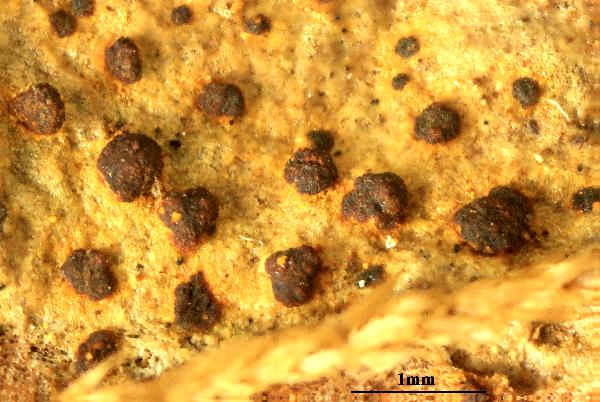Arthonia vinosa Leight.
Ann. Mag. Nat. Hist., ser. 2, 18: 331, 1856.
Synonyms: Arthonia lurida auct. ital. p.p. non Ach.; Coniangium luridum auct. non (Ach.) Fr.; Coniangium vinosum (Leight.) A. Massal.
Distribution: N - Frl, Ven (Nascimbene & al. 2005b, 2006c, 2013b, Thor & Nascimbene 2007), TAA (Thor & Nascimbene 2007, Nascimbene & al. 2007b, 2022, Nimis & al. 2015), Emil (Tretiach & al. 2008, Fariselli & al. 2020), Lig (Giordani & al. 2025). C - Tosc, Laz (Herb. Ravera 2887), Abr (Nascimbene & al. 2021), Sar (Cossu 2013). S - Cal (Puntillo 1996).
Description: Thallus crustose, thin, immersed or thinly powdery to granular, whitish to ochre-coloured, often stained yellow-orange, especially around the apothecia. Apothecia arthonioid, irregularly rounded in outline, 0,3-0.8(-1) mm across, 85-140 μm tall, sessile, with a convex, orange-red-brown to brown-black (red-brown when wet), epruinose disc, without a proper margin. Epithecium indistinct; hymenium yellow-orange to brownish, (30-)40-50(-60) µm high, K+ magenta and K+ purple (the pigments dissolving), I+ red-brown; paraphysoids 0.5-1.5 µm thick, usually not much swollen at apex; hypothecium dark red-brown in upper part, up to 30 µm high, K+ magenta and K+ purple. Asci 8-spored, broadly ovoid, semi-fissitunicate, with a large apical dome and a distinct ocular chamber, Arthonia-type. Ascospores 1-septate, with slightly unequal cells, ovoid-ellipsoid to slightly clavate, colourless (but old ascospores brown and warted), (9-)11-15(-17) x 4-6(-7) µm. Pycnidia frequent, orange-yellow, 0.4-0.6(-0.8) mm across, the wall red-brown, K+ strongly purple. Conidia bacilliform, straight or slightly curved, 4-6 x c. 1 µm. Photobiont trentepohlioid. Spot tests: thallus K+ purple on pigmented spots, C-, KC-, P-, UV-. Chemistry: unidentified anthraquinones in thallus and apothecia.Note: a mild-temperate lichen found near the base of old trees, mostly on rough bark, especially of oaks, more rarely on lignum, in very humid and closed-canopied deciduous forests. Young or depauperated forms may be confused with A. didyma. It is included in the Italian red list of epiphytic lichens as “Near-threatened” (Nascimbene & al. 2013c).
Growth form: Crustose
Substrata: bark and lignum
Photobiont: Trentepohlia
Reproductive strategy: mainly sexual
Most common in areas with a humid-warm climate (e.g. most of Tyrrenian Italy)
Commonnes-rarity: (info)
Alpine belt: absent
Subalpine belt: absent
Oromediterranean belt: absent
Montane belt: extremely rare
Submediterranean belt: extremely rare
Padanian area: absent
Humid submediterranean belt: extremely rare
Humid mediterranean belt: absent
Dry mediterranean belt: absent

Predictive model
Herbarium samples


Felix Schumm - CC BY 4.0
[VZ1986], Dania. Jutlandia: Sönder-Vissing, in silva Praestegaard
Skov prope Silkeborg, 100 m. Ad truncum Quercus petraeae vetustae.
Leg. M. S. Christiansen, 5.8.1983. EX A. VEZDA: LICHENES SELECTI
EXSICCATI NR. 1986.


P.L. Nimis; Owner: Department of Life Sciences, University of Trieste
Herbarium: TSB (9175)
2001/11/21


P.L. Nimis; Owner: Department of Life Sciences, University of Trieste
Herbarium: TSB (34899)
2002/02/19

Jacques Haine - Source: http://www.lichensmaritimes.org/index.php?task=fiche&lichen=604&lang=en
France, Ardennes

Jacques Haine - Source: http://www.lichensmaritimes.org/index.php?task=fiche&lichen=604&lang=en
France, Ardennes

Jacques Haine - Source: http://www.lichensmaritimes.org/index.php?task=fiche&lichen=604&lang=en
France, Ardennes

Jacques Haine - Source: http://www.lichensmaritimes.org/index.php?task=fiche&lichen=604&lang=en
France, Ardennes

Jacques Haine - Source: http://www.lichensmaritimes.org/index.php?task=fiche&lichen=604&lang=en
France, Ardennes

Jacques Haine - Source: http://www.lichensmaritimes.org/index.php?task=fiche&lichen=604&lang=en
France, Ardennes
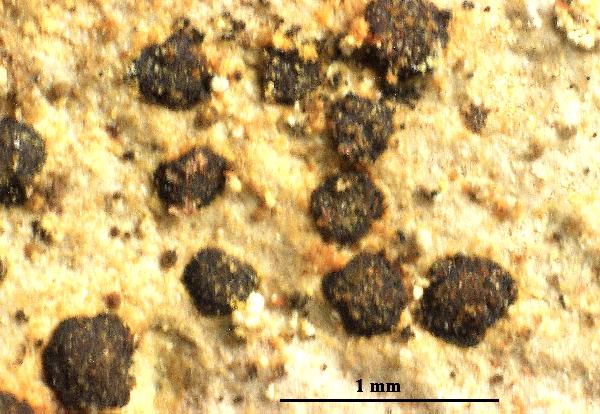

Felix Schumm - CC BY-SA 4.0
[VZR192], Bohemia merid., montes Šumava, distr. Klatovy, Modrava,
in monte "Smrkovy vrch", 1100 m. Ad corticem arborum vetustarum
(Acer pseudoplatanus). Leg. A. Vezda, 21.06.1995. EX A. VEZDA:
LICHENES RARIORES EXSICCATI NR. 192.
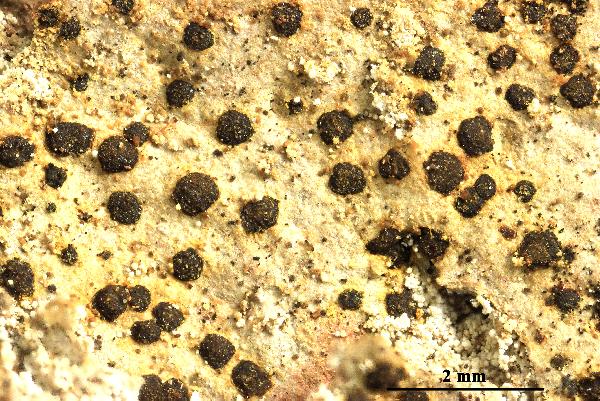

Felix Schumm - CC BY-SA 4.0
[VZR192], Bohemia merid., montes Šumava, distr. Klatovy, Modrava,
in monte "Smrkovy vrch", 1100 m. Ad corticem arborum vetustarum
(Acer pseudoplatanus). Leg. A. Vezda, 21.06.1995. EX A. VEZDA:
LICHENES RARIORES EXSICCATI NR. 192.
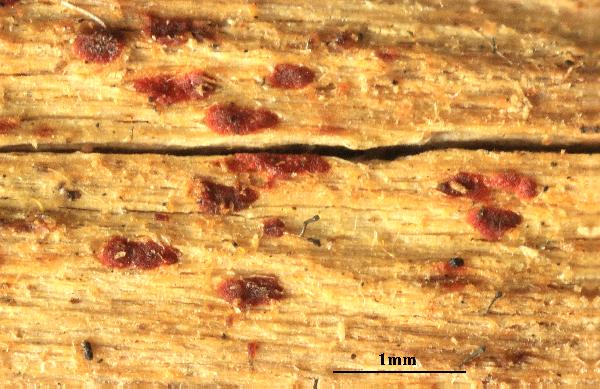

Felix Schumm - CC BY 4.0
[VZ1842], Nova Zelandia. North Island: Wellington, Tararua State
Forest, 17 km ad sept.-occid. versus a Masterton, 40°54' austr., 175°28'
orient., 550 m. Ad trncum decorticatum Nothofagi. Leg et det. L. Tibell
(no. 12933), 14.5.1982. Ex A. Vezda: Lichenes Selecti Exsiccati Nr.
1842.
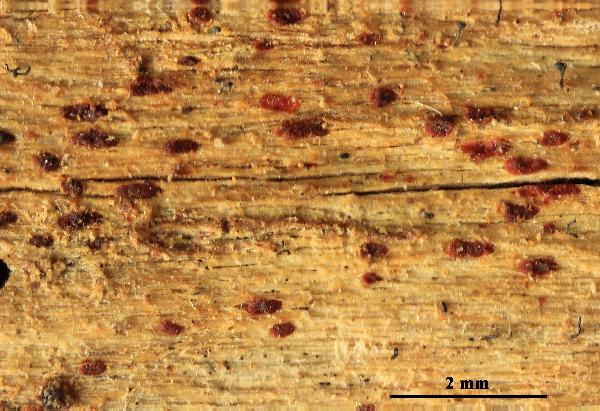

Felix Schumm - CC BY 4.0
[VZ1842], Nova Zelandia. North Island: Wellington, Tararua State
Forest, 17 km ad sept.-occid. versus a Masterton, 40°54' austr., 175°28'
orient., 550 m. Ad trncum decorticatum Nothofagi. Leg et det. L. Tibell
(no. 12933), 14.5.1982. Ex A. Vezda: Lichenes Selecti Exsiccati Nr.
1842.
Growth form: Crustose
Substrata: bark and lignum
Photobiont: Trentepohlia
Reproductive strategy: mainly sexual
Most common in areas with a humid-warm climate (e.g. most of Tyrrenian Italy)
Commonnes-rarity: (info)
Alpine belt: absent
Subalpine belt: absent
Oromediterranean belt: absent
Montane belt: extremely rare
Submediterranean belt: extremely rare
Padanian area: absent
Humid submediterranean belt: extremely rare
Humid mediterranean belt: absent
Dry mediterranean belt: absent

Predictive model
| Herbarium samples |


Felix Schumm - CC BY 4.0
[VZ1986], Dania. Jutlandia: Sönder-Vissing, in silva Praestegaard Skov prope Silkeborg, 100 m. Ad truncum Quercus petraeae vetustae. Leg. M. S. Christiansen, 5.8.1983. EX A. VEZDA: LICHENES SELECTI EXSICCATI NR. 1986.


P.L. Nimis; Owner: Department of Life Sciences, University of Trieste
Herbarium: TSB (9175)
2001/11/21


P.L. Nimis; Owner: Department of Life Sciences, University of Trieste
Herbarium: TSB (34899)
2002/02/19

Jacques Haine - Source: http://www.lichensmaritimes.org/index.php?task=fiche&lichen=604&lang=en
France, Ardennes

Jacques Haine - Source: http://www.lichensmaritimes.org/index.php?task=fiche&lichen=604&lang=en
France, Ardennes

Jacques Haine - Source: http://www.lichensmaritimes.org/index.php?task=fiche&lichen=604&lang=en
France, Ardennes

Jacques Haine - Source: http://www.lichensmaritimes.org/index.php?task=fiche&lichen=604&lang=en
France, Ardennes

Jacques Haine - Source: http://www.lichensmaritimes.org/index.php?task=fiche&lichen=604&lang=en
France, Ardennes

Jacques Haine - Source: http://www.lichensmaritimes.org/index.php?task=fiche&lichen=604&lang=en
France, Ardennes


Felix Schumm - CC BY-SA 4.0
[VZR192], Bohemia merid., montes Šumava, distr. Klatovy, Modrava, in monte "Smrkovy vrch", 1100 m. Ad corticem arborum vetustarum (Acer pseudoplatanus). Leg. A. Vezda, 21.06.1995. EX A. VEZDA: LICHENES RARIORES EXSICCATI NR. 192.


Felix Schumm - CC BY-SA 4.0
[VZR192], Bohemia merid., montes Šumava, distr. Klatovy, Modrava, in monte "Smrkovy vrch", 1100 m. Ad corticem arborum vetustarum (Acer pseudoplatanus). Leg. A. Vezda, 21.06.1995. EX A. VEZDA: LICHENES RARIORES EXSICCATI NR. 192.


Felix Schumm - CC BY 4.0
[VZ1842], Nova Zelandia. North Island: Wellington, Tararua State Forest, 17 km ad sept.-occid. versus a Masterton, 40°54' austr., 175°28' orient., 550 m. Ad trncum decorticatum Nothofagi. Leg et det. L. Tibell (no. 12933), 14.5.1982. Ex A. Vezda: Lichenes Selecti Exsiccati Nr. 1842.


 INDEX FUNGORUM
INDEX FUNGORUM
 GBIF
GBIF
 DOLICHENS
DOLICHENS




